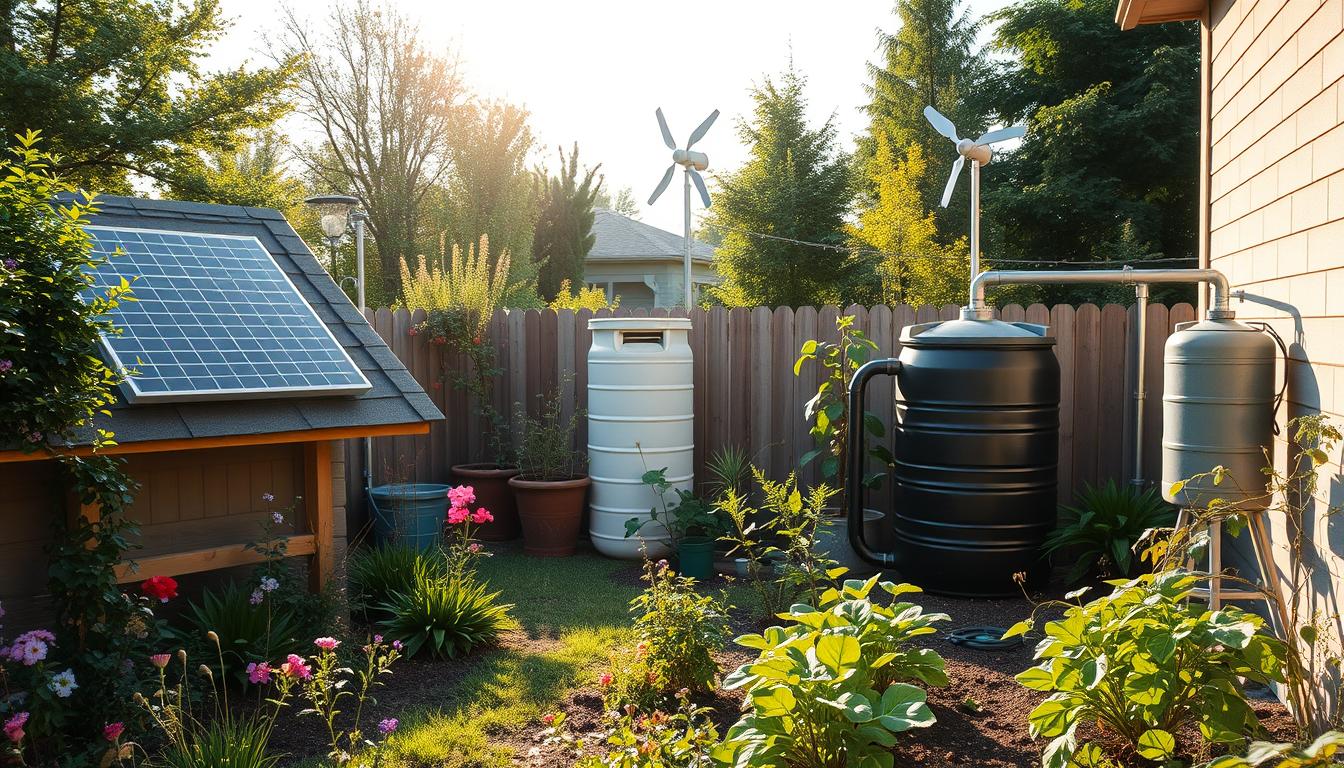As you stand at your mailbox, you can’t help but feel frustrated with high energy bills. It’s more than just annoying; it’s a call to action. But there’s good news: you have the power to change this.
Explore the world of alternative energy solutions. Your home can become a source of sustainable power. It’s not just solar panels anymore. Geothermal heat pumps and wind energy systems are just the beginning.
Imagine cutting your energy bills in half or even eliminating them. Picture your home powering itself and even making money by selling extra energy. This dream is now a reality for you.
Starting your journey to energy independence is easy. Did you know geothermal heat pumps are three times more efficient than traditional systems? Or that a solar water heater can meet half your hot water needs? These are just a few examples of clean energy technologies available to you.
But here’s the best part: with government incentives, the cost of these systems can drop significantly. Many homeowners see their systems pay off in just a few years. This leads to decades of savings and sustainable power.
As we explore affordable alternative energy solutions, you’ll learn how to make your home more efficient. You’ll discover various sustainable power options and the financial benefits they offer. Get ready to take control of your energy future and join the movement towards a cleaner, more sustainable world.
Key Takeaways
- Alternative energy solutions can significantly reduce or eliminate home energy bills
- Geothermal heat pumps offer superior efficiency compared to traditional systems
- Solar water heating can meet up to 50% of a family’s hot water needs
- Federal and state incentives make renewable energy systems more affordable
- Grid-connected systems allow homeowners to sell excess energy back to utility providers
- Renewable energy investments can pay for themselves within 10-15 years
- A variety of alternative energy options exist beyond solar, including wind and geothermal
Understanding Alternative Energy Solutions
Green energy solutions are changing how we power our homes and businesses. They offer a cleaner choice than traditional fossil fuels. This helps lower our carbon footprint and supports sustainable power.
What Are Alternative Energy Solutions?
Alternative energy solutions use new technologies to tap into renewable resources. This includes solar panels, wind turbines, and geothermal systems. Each one has its own benefits for both homes and the environment.
The Growing Importance of Sustainable Power
Sustainable power is key in our battle against climate change. In 2022, renewable energy beat coal in U.S. electricity generation for the first time. By 2025, solar energy is expected to grow by 75%, and wind power by 11%.
Economic Benefits of Alternative Energy
Choosing eco-friendly energy can save a lot of money. Solar homes can sell extra electricity back to the grid. Geothermal systems can pay off in 5 to 10 years. The cost to install solar in the U.S. is about $12,000 after tax credits, making it a good deal for many.
| Energy Source | Benefit | Payback Period |
|---|---|---|
| Solar | Sell excess power to grid | Varies |
| Geothermal | Consistent heating/cooling | 5-10 years |
| Wind | Reduced grid reliance | 6 months (carbon footprint) |
The U.S. has enough renewable resources to power over 100 times our annual electricity needs. By choosing green energy, you help the environment and save money in the long run.
Getting Started with Home Energy Efficiency
Boosting your home’s energy efficiency is a great first step toward sustainable living. By focusing on key areas, you can cut energy costs and reduce your carbon footprint.
Energy Assessment Fundamentals
A home energy assessment is key to finding ways to improve. It checks how much energy your home uses and finds where it’s wasted. Did you know tracking your energy use can save up to 8% on bills?
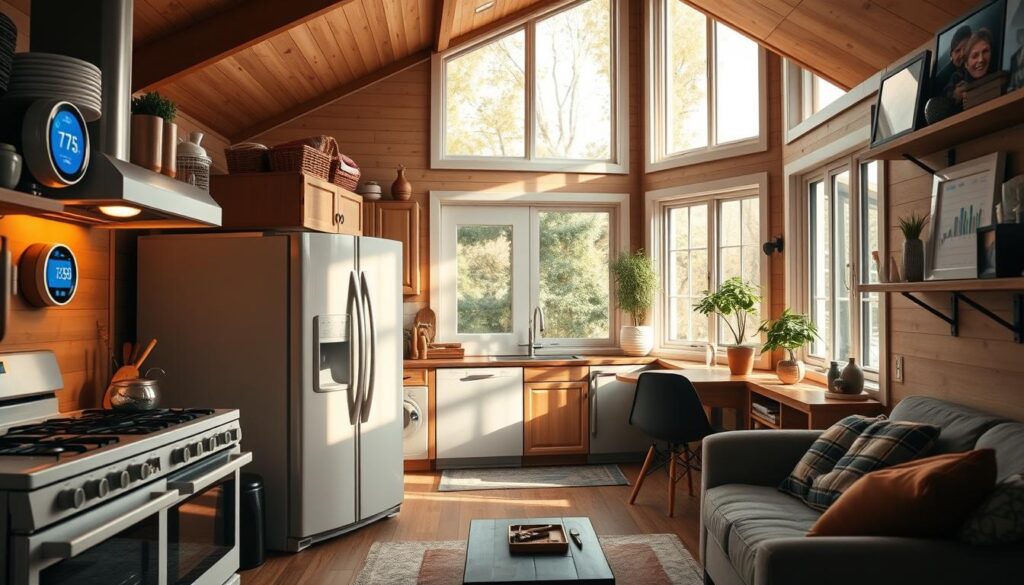
Insulation and Air Sealing Basics
Insulation and air sealing are essential for comfort and saving energy. Heating is the biggest part of a typical home’s energy bill. Improving these areas can make your home cozy and lower your bills.
- Check attic insulation levels
- Seal gaps around windows and doors
- Insulate walls and floors
Smart Energy Management Systems
Smart energy systems can make your home more efficient. For example, Schneider Electric’s Wiser system helps save energy when you’re away and uses solar power for heating.
| Energy Consumption Area | Typical Percentage of Energy Bill |
|---|---|
| Heating | Over 50% |
| Lighting | Less than 5% |
| Other (appliances, electronics, etc.) | Approximately 45% |
By focusing on these key areas, you can make your home more comfortable, cost-effective, and eco-friendly.
Geothermal Heat Pump Systems
Geothermal heat pumps are a top choice for heating and cooling your home. They use the Earth’s constant temperature underground. This makes them a great way to use renewable energy.
How Geothermal Systems Work
These systems use the Earth’s stable temperature, which stays between 50°F and 59°F 30 feet down. This temperature is perfect for heating and cooling your home efficiently.
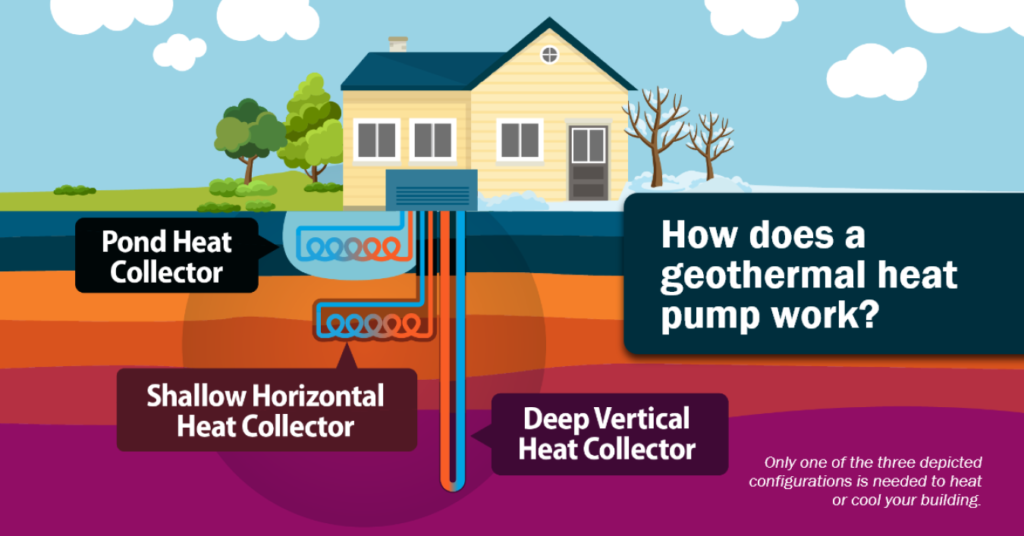
Cost-Benefit Analysis of Geothermal Installation
Geothermal systems cost more upfront than traditional ones. But, they can save you money in 5 to 10 years. The U.S. Department of Energy says they could save a lot of energy by 2050.
Maintenance Requirements and Longevity
Geothermal systems last a long time. The indoor parts can last up to 24 years. The ground loop can work for over 50 years. With little upkeep, they keep your home comfortable for years.
| System Component | Lifespan | Maintenance |
|---|---|---|
| Indoor Components | Up to 24 years | Regular filter changes |
| Ground Loop | 50+ years | Minimal to none |
| Entire System | Decades | Annual professional check-up |
Choosing a geothermal heat pump is a smart move. It’s a long-lasting, energy-saving option. It uses renewable energy from your backyard.
Wind Energy for Residential Use
Wind power is becoming more popular for homes. Residential wind turbines are a green way to make electricity and cut down on grid use. If you’re thinking about this option, here’s what you need to know.
Home wind turbines vary in size, from 400 watts to 20 kilowatts. For a big impact, choose a 5-15 kilowatt turbine. This can cover a lot of your home’s yearly electricity use, about 10,649 kilowatt-hours.
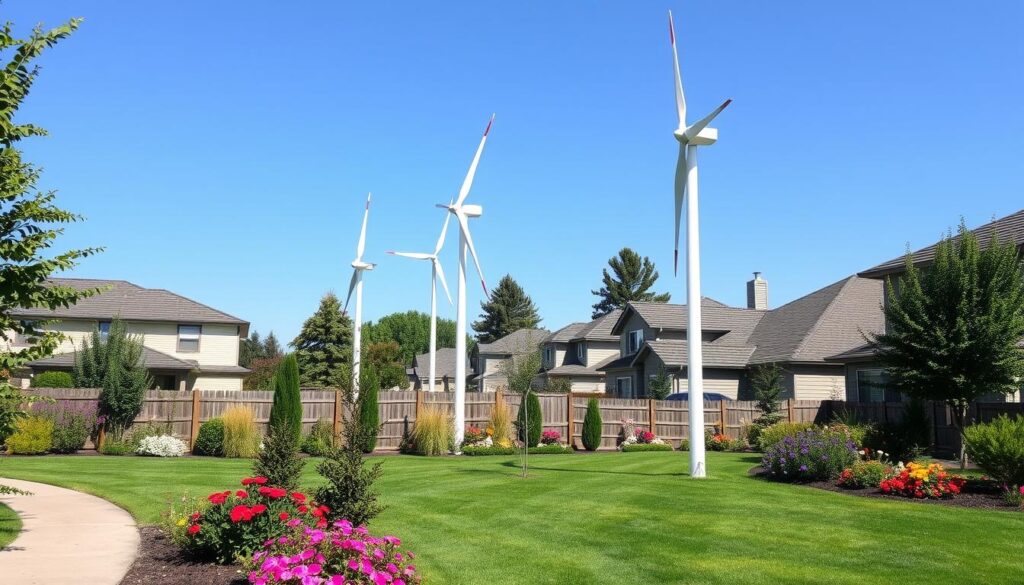
The success of home wind turbines depends on your area’s wind speed. For example, a 1.5-kilowatt turbine in windy areas can power a home using 300 kilowatt-hours monthly. Think about these points to see if wind power is for you:
- Property size: You’ll need at least one acre of land
- Average wind speed: Aim for at least 10 mph annually
- Local zoning laws: Many areas limit structure height to 35 feet
- Noise levels: A 2-kilowatt turbine produces about 55 dB at 50 feet
Installing residential wind turbines costs between $10,000 to $70,000. The upfront cost might seem high, but these systems can save money and give you energy freedom. You can even get credits for extra energy you make.
| Wind Turbine Size | Typical Power Output | Suitable For |
|---|---|---|
| 400 watts – 1 kW | Small appliances, partial home power | Off-grid cabins, boats |
| 1 kW – 5 kW | Significant home power contribution | Energy-efficient homes, partial grid independence |
| 5 kW – 15 kW | Full home power needs | Large homes, full grid independence |
| 15 kW – 20 kW | Excess power generation | Farms, small businesses, power selling |
Choosing wind power saves you money and helps the environment. It also supports green energy in your community.
Solar Water Heating Technologies
Solar water heating is a smart way to use solar energy for daily needs. It cuts down on the need for traditional water heating.
Types of Solar Water Heaters
Solar water heaters are mainly active or passive. Active systems use pumps and controls. Passive systems work with natural flow.
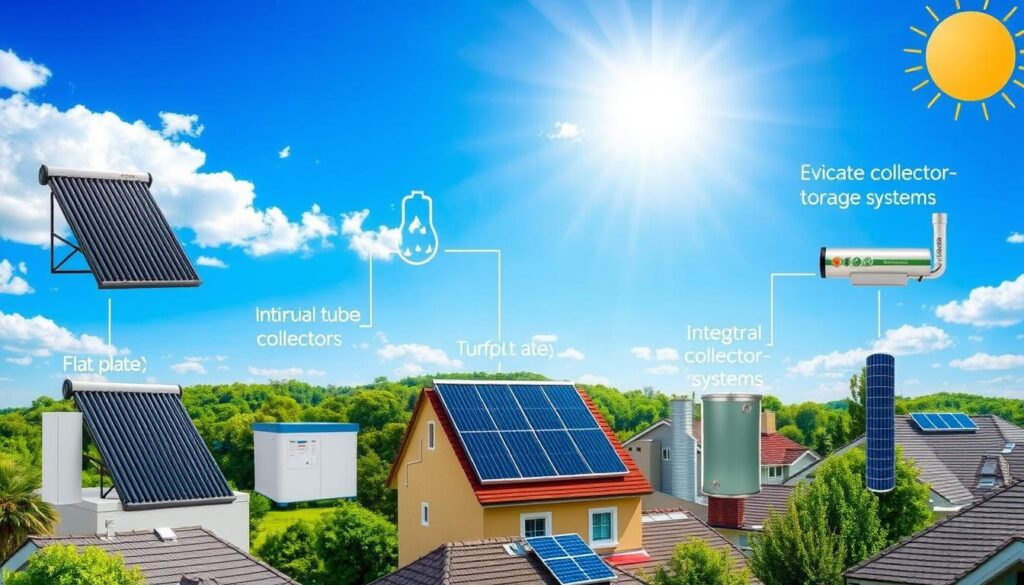
- Flat-plate collectors
- Integral collector-storage systems
- Evacuated-tube solar collectors
Installation Requirements and Costs
Setting up a solar water heater costs $5,000 to $7,000. It should face south and get little shade from 8 AM to 4 PM. A 3-bedroom home needs an 80-gallon tank, with 120-gallon for bigger homes.
Efficiency and Performance Factors
Solar water heaters can meet 70-90% of your water needs. They save up to 38% on energy costs. They also cut CO2 emissions by over 30%.
“The drainback solar water heating system is the most efficient indirect system on the market, preventing freezing and overheating.”
Keep your system in good shape with regular checks. Simple systems need checks every 3-5 years. Electrical parts might need a replacement after 10 years.
Choose a contractor with experience and the right certifications. This ensures your system is installed and maintained well.
Battery Storage Solutions and Grid Independence
Battery storage solutions are changing how we get power. They let you save extra energy from solar panels or wind turbines. This makes your power use more independent from the grid.
Lithium-ion batteries are at the forefront of energy storage. They pack a lot of power, are very efficient, and last a long time. With over 5,000 charge cycles, they’re a smart choice for saving money over the long haul. Plus, they’re small enough for homes and businesses.
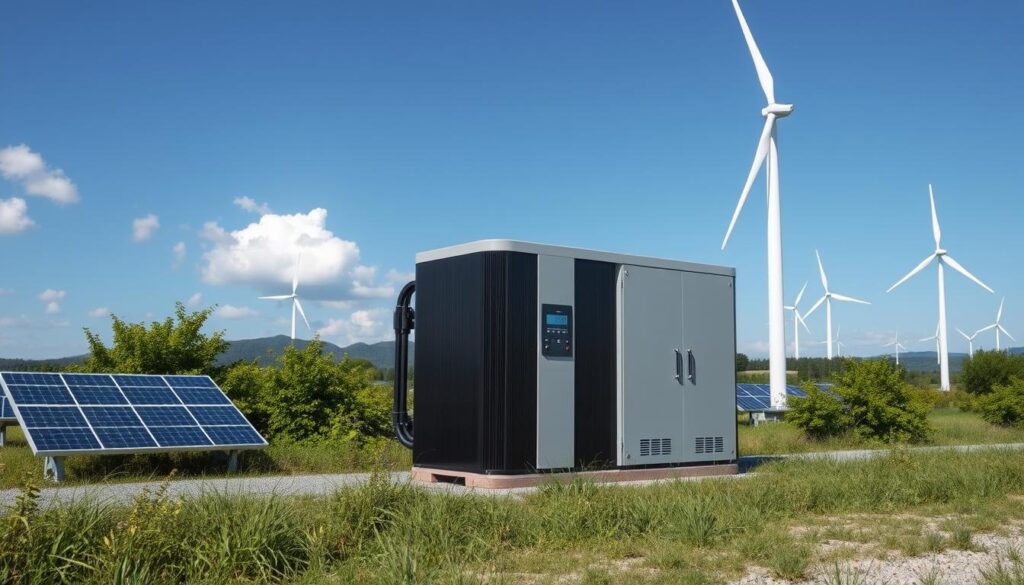
Having battery storage means you don’t need to rely on the grid as much. This saves money and keeps your power on during outages. Battery systems are great backups, keeping important things running when the power goes out.
Battery storage does more than just help homes. It also:
- Helps keep the grid stable by balancing energy supply and demand
- Allows for energy trading to save money
- Makes it easier to use more renewable energy
- Helps reduce the grid’s load during busy times
Getting battery storage boosts your energy freedom and helps the planet. As technology gets better, these systems will be even more affordable and effective. This leads to a cleaner, greener future.
| Battery Type | Energy Density | Cycle Life | Efficiency |
|---|---|---|---|
| Lithium-Ion | High | 5,000+ | 90-95% |
| Lead-Acid | Low | 500-1,000 | 70-85% |
| Solid-State | Very High | 10,000+ | 95-99% |
Cost Analysis and Financial Incentives
Investing in renewable energy can be more affordable than you think. The U.S. government offers various incentives to help homeowners. These incentives make sustainable energy solutions more accessible to many households.
Federal Tax Credits and Rebates
The federal government provides significant tax credits for renewable energy installations. The Inflation Reduction Act of 2022 extended tax credits for wind projects through 2024. These credits can greatly reduce your expenses.
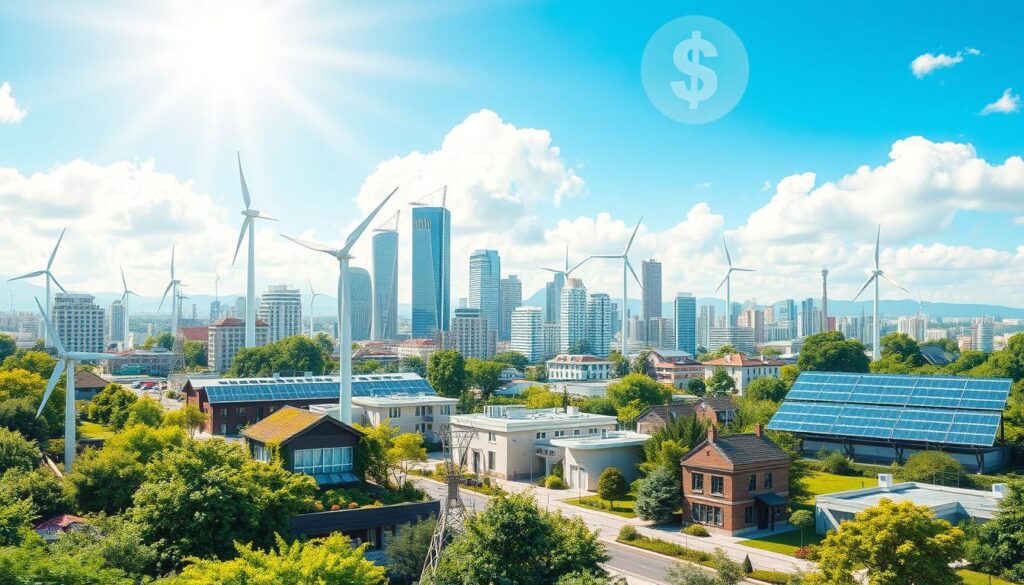
State-Level Incentive Programs
Many states offer additional energy rebates and incentives. These programs vary by location but often include property tax exemptions and sales tax exemptions. Check your state’s energy office website for specific offerings in your area.
Return on Investment Calculations
When calculating your return on investment, consider both immediate savings and long-term benefits. Think about reduced energy bills and the chance to sell excess power back to the grid. Also, consider the increased property value. The payback period for most renewable energy systems ranges from 5 to 15 years, depending on your location and energy usage.
| Incentive Type | Potential Savings | Eligibility |
|---|---|---|
| Federal Tax Credit | Up to 30% of system cost | All homeowners |
| State Tax Credit | Varies by state (0-25%) | State residents |
| Utility Rebates | $500 – $5000 | Varies by utility |
| Performance Incentives | $0.02 – $0.15 per kWh produced | System owners |
Remember, these tax credits and energy rebates can significantly reduce your upfront costs. By taking advantage of available incentives, you can make your transition to renewable energy more affordable. This will also help you get a faster return on your investment.
Community-Based Energy Solutions
Community-based energy solutions are changing how we view sustainable power. They unite neighbors to form shared renewable energy systems. These systems benefit everyone involved.
Shared Solar Programs
Community solar projects let you buy or lease part of a big solar system. This makes renewable energy available to renters and those with bad roof spots. The National Community Solar Partnership+ backs many solar projects, like those for low-income homes and schools.
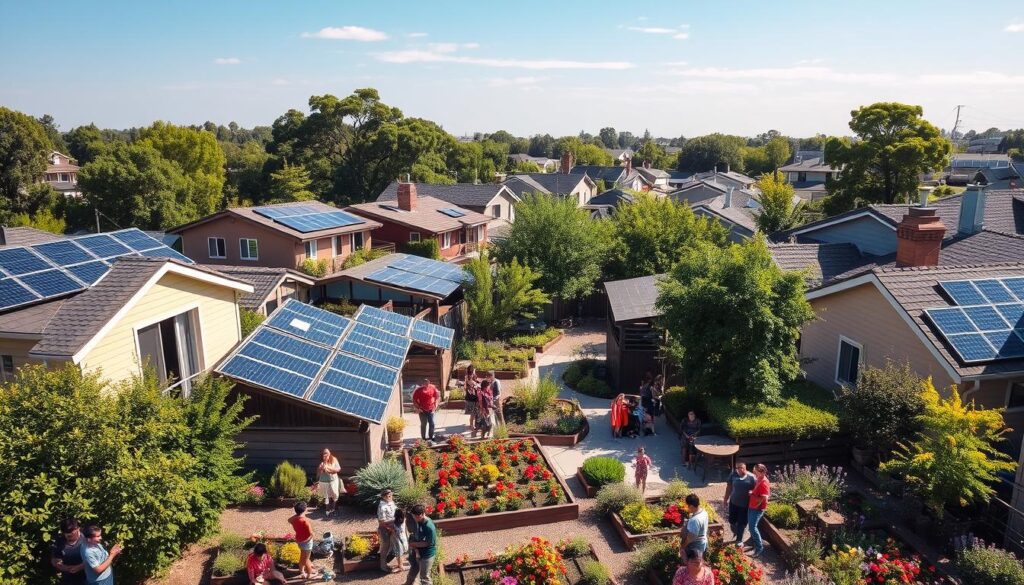
Cooperative Energy Projects
Cooperative energy projects are growing in the US. They use wind turbines, solar panels, or focus on energy efficiency. In Europe, 2 million people join 23,000 community energy projects in 30 countries. They aim for 45% of their renewable energy to be community-owned by 2050.
Municipal Energy Initiatives
Cities are leading in energy with their own initiatives. For example, the US Department of Energy gave $10 million to three projects on local energy. The Communities LEAP program turns old mining sites into clean hydrogen plants, creating jobs in areas hit by industry loss.
Community energy solutions have many advantages. They lower costs, make energy stable, and help against natural disasters. By using local energy, these projects boost the economy and create jobs. They also cut down on fossil fuel use and improve health.
“Community energy projects bring both economic and environmental benefits to local areas.”
Maintenance and Long-Term Sustainability
Keeping your renewable energy systems in top shape is vital. Smart upkeep practices help your clean energy technologies work better and last longer.
Solar panels are tough and need little care. But, cleaning them often can make them work even better. Geothermal heat pumps are also very durable and only need occasional checks to keep running smoothly.
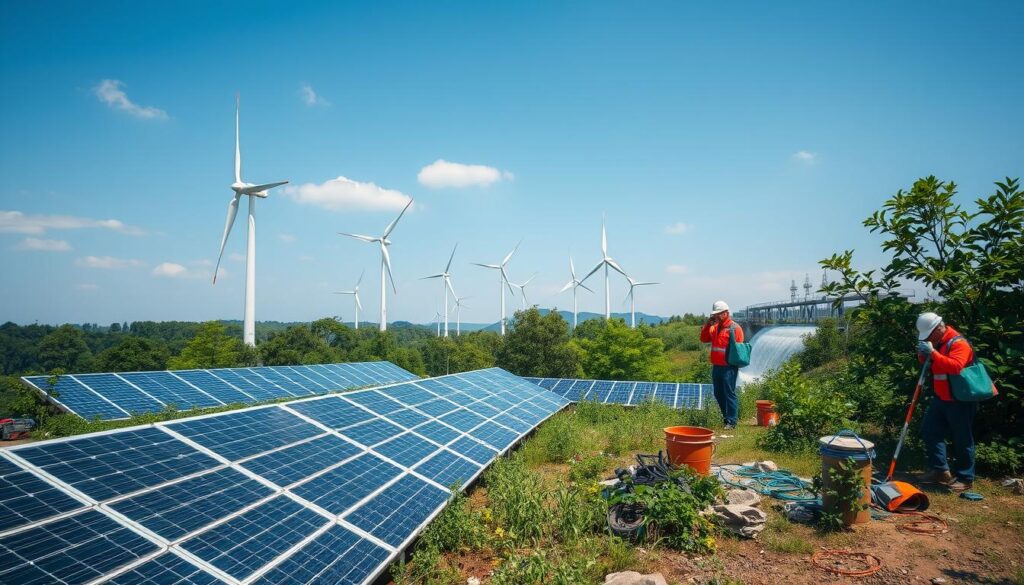
Wind turbines, on the other hand, need more regular checks. It’s important to inspect and service their moving parts often. Also, getting a professional to do annual maintenance can help spot problems early.
“Proactive maintenance is the cornerstone of sustainable power generation. It’s not just about fixing problems; it’s about preventing them.”
Battery storage systems are key for being energy independent. They need regular checks to work at their best. By keeping up with maintenance, you’ll make your clean energy systems last longer and get more value from them.
| System | Maintenance Frequency | Key Tasks |
|---|---|---|
| Solar Panels | Bi-annually | Cleaning, inspection for damage |
| Wind Turbines | Quarterly | Lubrication, blade inspection |
| Geothermal Heat Pumps | Annually | System pressure check, filter replacement |
| Battery Storage | Monthly | Charge level check, terminal cleaning |
Even though these systems are made to last, your care is what keeps them running well. Your efforts will ensure they keep providing clean, efficient energy for many years.
| Discover Edison’s Lost Energy Secret Ready for a true energy revolution? Thomas Edison may have left behind a lost invention that could generate unlimited, on-demand power. Explore how this groundbreaking discovery could change the future of energy—affordably and sustainably. Learn More About Edison’s Lost Invention Here |
Conclusion
Alternative energy solutions are key for a sustainable future. Right now, only 11.4% of global energy comes from renewable sources. This leaves a lot of room for growth.
Methods like geothermal, solar, and wind are promising alternatives to fossil fuels. These make up just 15.7% of global energy, while fossil fuels dominate at 84.3%.
You can make a big difference by using these technologies. Options like geothermal heat pumps and solar water heaters can help reduce your carbon footprint. Community solar programs also make renewable energy more accessible, even if you can’t install systems on your property.
To reach net-zero emissions by 2050, we need a big increase in renewable energy. This means using efficient appliances and technologies. Choosing energy-efficient options like LED lighting and electric cookers helps a lot.
Remember, the journey to sustainable energy starts at home. Every small step you take helps make our future greener.
FAQ
What are alternative energy solutions?
Alternative energy solutions are clean, renewable power sources. They are better than traditional fossil fuels. Examples include solar panels, wind turbines, and geothermal heat pumps.
These technologies help homeowners save energy and money. They also reduce environmental harm.
How can I improve my home’s energy efficiency before installing renewable energy systems?
Start by doing an energy assessment. Then, add insulation and seal air leaks.
Use energy-efficient windows and appliances. Also, use daylight and native plants to save energy.
How do geothermal heat pumps work?
Geothermal heat pumps use the ground for heat. They are very efficient because the ground stays warm or cool year-round.
This makes them great for heating and cooling homes.
What are the requirements for installing a residential wind energy system?
You need at least one acre of land and strong winds. The system’s power can range from 5 to 30 kilowatts.
The tower height depends on nearby wind blocks. Costs vary from ,000 to ,000.
How do solar water heaters work and what are their benefits?
Solar water heaters use sunlight to heat water. They have insulated tanks and solar collectors.
They can meet up to 50% of a family’s hot water needs. They need a backup for low sunlight times.
What are the advantages of battery storage systems?
Battery storage systems save excess energy. This energy can be used when needed, like at night or during outages.
They make homes more independent and save money on bills.
Are there financial incentives available for installing alternative energy systems?
Yes, there are federal and state incentives. The Database of State Incentives for Renewables & Efficiency helps find local ones.
Many states also let homeowners sell extra electricity back to the grid. This speeds up the cost savings.
What are community solar projects?
Community solar projects let people share a solar system. This way, more people can use solar energy, even if they can’t install panels themselves.
The National Community Solar Partnership+ helps with these projects across the U.S.
How much maintenance do alternative energy systems require?
Maintenance needs vary. Solar panels need little care and can handle harsh weather.
Geothermal systems are also durable. Wind turbines might need more checks. Regular upkeep is key for these systems.
What is the typical return on investment for alternative energy solutions?
The return varies by system and location. Geothermal systems can save money in 10 to 15 years.
Solar and wind systems can also pay off, thanks to incentives and selling back to the grid. Long-term, they save money and can even earn extra.
Source Links
- Residential Renewable Energy
- Alternative Energy 101 | What It Is and Why It Is Important?
- Renewable Energy: The Clean Facts
- Renewable Energy
- Alternative Energy Sources: What is Alternative Energy? | Inspire Clean Energy
- Planning for Home Renewable Energy Systems
- [Home Energy Efficiency Series] Step 1: Getting started with a Home Energy Management solution (HEMS)
- Geothermal Heat Pumps
- Geothermal Heat Pumps
- Installing and Maintaining a Small Wind Electric System
- WINDExchange: Small Wind Guidebook
- Solar Water Heaters
- No title found
- Battery Energy Storage: How it works & why it’s important – EVESCO
- Technological Advancements in Battery Storage: What’s Next for the Power Grid?
- How Battery Storage Solutions Can Enhance Solar Energy Systems • Signature Electric
- WINDExchange: Wind Energy Financial Incentives
- Financial Incentives to Enable Clean Energy Deployment: Policy Overview and Good Practices
- Your Way: Place-Based Solutions for a Local Clean Energy Transition
- Community Energy | EESI
- An Overview of Community Energy and Its Benefits | Earth.Org
- What is Sustainable Energy and Why Do We Need It?
- Maintenance practices for all-electric utilities | HFM Magazine
- Renewable Energy Advantages & Disadvantages | IBM
- Can renewable energy replace fossil fuels in the future?
- Conclusion and Recommendations – CLASP
Affiliate Disclosure: This article contains affiliate links, meaning I may earn a commission if you click through and make a purchase, at no extra cost to you.


